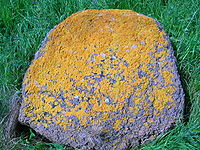
Crustose
Encyclopedia

Habit (biology)
Habit, when used in the context of biology, refers to the instinctive actions of animals and the natural tendencies of plants.In zoology, this term most often refers to specific behavioral characteristics, even when directly related to physiology...
of some types of algae
Algae
Algae are a large and diverse group of simple, typically autotrophic organisms, ranging from unicellular to multicellular forms, such as the giant kelps that grow to 65 meters in length. They are photosynthetic like plants, and "simple" because their tissues are not organized into the many...
in which the plant grows tightly appressed to a substrate forming a biological layer of the adhering organism. Some species of marine algae
Algae
Algae are a large and diverse group of simple, typically autotrophic organisms, ranging from unicellular to multicellular forms, such as the giant kelps that grow to 65 meters in length. They are photosynthetic like plants, and "simple" because their tissues are not organized into the many...
of the Rhodophyta, in particular members of the order
Order (biology)
In scientific classification used in biology, the order is# a taxonomic rank used in the classification of organisms. Other well-known ranks are life, domain, kingdom, phylum, class, family, genus, and species, with order fitting in between class and family...
Corallinales, family
Family (biology)
In biological classification, family is* a taxonomic rank. Other well-known ranks are life, domain, kingdom, phylum, class, order, genus, and species, with family fitting between order and genus. As for the other well-known ranks, there is the option of an immediately lower rank, indicated by the...
Corallinaceae
Corallinaceae
The Corallinaceae are one of the two extant Coralline families of red algae; they are differentiated from the morphologically similar Sporolithaceae by their formation of grouped sporangial chambers, clustered into sori...
, subfamily Melobesioideae
Melobesioideae
The Melobesioideae are a subfamily of Corallinacean Coralline alga with multiporate conceptacles....
with cell walls containing calcium carbonate
Calcium carbonate
Calcium carbonate is a chemical compound with the formula CaCO3. It is a common substance found in rocks in all parts of the world, and is the main component of shells of marine organisms, snails, coal balls, pearls, and eggshells. Calcium carbonate is the active ingredient in agricultural lime,...
grow to great depths in the intertidal zone, forming crusts on various substrates. The substrate can be rocks throughout the intertidal zone, or, as in the case of the Corallinales, reef-building corals
Coral reef
Coral reefs are underwater structures made from calcium carbonate secreted by corals. Coral reefs are colonies of tiny living animals found in marine waters that contain few nutrients. Most coral reefs are built from stony corals, which in turn consist of polyps that cluster in groups. The polyps...
, and other living organisms including plants, such as mangrove
Mangrove
Mangroves are various kinds of trees up to medium height and shrubs that grow in saline coastal sediment habitats in the tropics and subtropics – mainly between latitudes N and S...
s and animals such as shelled molluscs. The corraline red algae are major members of coral reef communities, cementing the corals together with their crusts. Among the brown algae
Brown algae
The Phaeophyceae or brown algae , is a large group of mostly marine multicellular algae, including many seaweeds of colder Northern Hemisphere waters. They play an important role in marine environments, both as food and for the habitats they form...
, the order Ralfsiales
Ralfsiales
Ralfsiales is an order of crustose brown algae containing two families.-External links:...
comprises two families of crustose algae.
Many lichen
Lichen
Lichens are composite organisms consisting of a symbiotic organism composed of a fungus with a photosynthetic partner , usually either a green alga or cyanobacterium...
s also grow close to the surface of rocks, tree trunks and other substrata, and are referred to as crustose lichens. Crustose organisms can be detrimental to engineered structures when found on buildings, coastal structures, and ships.

